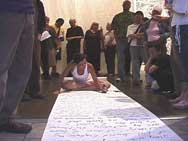
![]()
ReCut Project
Weekly performances from June 30-August 18, 2006
Los Angeles Contemporary Exhibitions (LACE)
Cut
Piece |
The ReCut Project was conceived while Ma was researching the
Fluxus material in the Jean Brown collection at the Getty Research Institute.
From the phenomenal amount of reportage and commentary around Yoko Ono,
one of the artists participating in Fluxus (and by then the wife of John
Lennon), Ma became fascinated by how the art press, society writers, gossip
columnists, and music writers responded to her artwork. It seemed that
the same actions, performed in different historical, social, political,
and cultural contexts, could yield very different interpretations.
He based his concept for the ReCut Project in this realization.
Ma chose the Cut Piece (1964-66), one of Ono’s most well
known actions, and one that was frequently mentioned in the archive, as
his starting point.
In the ReCut Project, Ma invited a diverse group of individuals
to present their interpretation of Ono’s instructions. They represent
a wide range of positions in terms of age, nationality, gender, vocation
and practice; some are immigrants, some are troubled by what the US represent
in the world today; a few are recently college and high school students,
while others are tenured university professors. They are Asian, Iranian,
Latino, queer, feminist, or none of the above. At least one embodies the
Ono/Lennon dichotomy: a Japanese woman artist rock star. They have different
relationship to their bodies: living with HIV, battling cancer, being
mistaken for a terrorist, being a virgin, being bi-racial. In turning
Ono’s singular performance into a series of actions designed by
a group of artists, writers, musicians, and youth participants, Ma is
interested in the possible shifts in meaning and interpretations of Ono’s
“original” that can result from this multiplicity.
The resulted performances were presented on a weekly basis throughout
the duration of Draw a Line and Follow It. They took place in
different locations within the gallery space of LACE, over digital transmission,
and out on Hollywood Boulevard. Sometimes they were presented in conjunction
with other artists’ actions and performances based on Fluxus instructions.
A 40 minute documentary of the ReCut Project is available on DVD upon request.
| About
Draw
a Line and Follow It Titled after LaMonte Young's Composition 1960 No. 10, a performance score consisting of the instruction 'Draw a straight line and follow it,' this exhibition traces connections from George Brecht, Jackson Mac low, Yoko Ono, Mieko Shiomi, Robert Watts and others to a contemporary generation of artists that share an interest in the Fluxus practices of the 1960's and 70's. These LA-based artists were invited to explore Fluxus objects in the Jean Brown Collection at the Getty Research Institute. Each picked a score to instigate a new work - producing drawings, installations and performances (planned and spontaneous) throughout the summer at LACE |
.Back
|
|



